Lecture 20 Protein Translocation and Secretion
1/20
There's no tags or description
Looks like no tags are added yet.
Name | Mastery | Learn | Test | Matching | Spaced |
|---|
No study sessions yet.
21 Terms
Translocation vs Secretion
Translocation = transport proteins into or through a membrane
Secretion = transport of proteins to bacterial cell surface or to outside the cell
Locations in the cell that protein which are made in the cytoplasm are needed
Cytoplasmic Membrane (transport systems)
Periplasmic proteins (enzymes, binding proteins)
outer membrane in gram negative cell (porins)
extracellular proteins (enzymes, toxins, virulence proteins, pili, S-layer… DRUG Targets)
Translocation and Secretion Systems
Translocation; To cytoplasmic membrane or periplasm
Sec system = General Secretion , SRP; Signal Recognition Particle System
Tat system = Twin Arginine Translocation
Secretion; to outside of cell
Types I-VI, used by Gram - virulence
Types VII, used by Gram +
Sec System
A protein translocation system that facilitates the general secretion of proteins into/across the cytoplasmic membrane. Proteins translocated unfolded,
Key components:
Leader peptide, Chaperone protein (SecB), membrane-bound 3 protein complex (SecYEG), Cytoplasmic ATPase (SecA).
SecA + SecYEG = translocase.
Leader Peptide (signal peptide)
Plays an important role for attaching or inserting a protein into/through a membrane. Is a 20-30 amino acid sequence at the amino-terminal end of the protein that is removed during or after translocation by signal peptidase.
Prevents protein from folding with help from SecB (if folded cant be transported)
protein + leader peptide = preprotein.
Does NOT determine the final destination of the protein.
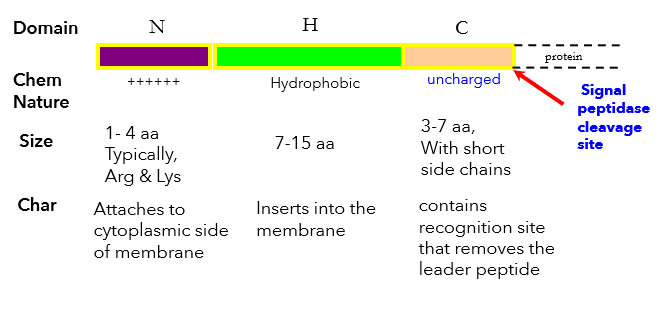
Chaperone Protein (helper)
Bring the preprotein to the membrane, help prevent folding.
SecB, binds to mature protein not leader peptide.
SecB binds SecA which is attached to the membrane via SecYEG, thus delivers protein to SecA.
SecA and SecYEG
SecA attached to SecYEG forms the translocase complex that facilitates the transport of preproteins across the cytoplasmic membrane.
SecYEG bound to the membrane
SecA couples ATP hydrolysis to translocation, pushes protein through channel.
Sec Pathway
synthesized pre-protein binds with SecB (signal peptide recognized by SecB)
SecB/preprotein binds to SecA
SecA/preprotein complex binds SecYEG
SecB released, conformational change in SecA-SecYEG, ATP hydrolyzed.
ATP hydrolysis provides energy to transport preprotein through SecYEG channel
SecA released, signal peptidase cleaves leader peptide
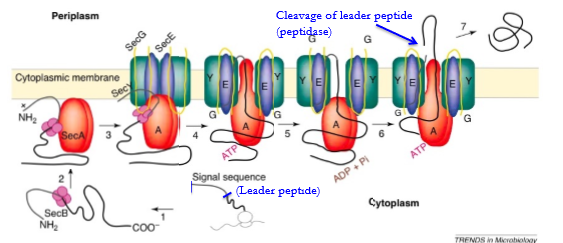
Signal Recognition Particle (SRP)
Transport unfolded proteins to the cytoplasmic membrane. SRP is a ribonucleoprotein (RNA molecule+Ffh protein;GTPase)
Co-translational Translocation; The ribosome binds at the translocon SecYEG and synthesizes the protein as it is translocated.
SRP Pathway
Pre-protein is synthesized in the ribosome and the signal sequence binds to the SRP.
SRP complex binds FtsY membrane receptor at the SecYEG complex.
Signal sequence is released from the SRP and ribosome docks to SecYEG Signal sequence opens SecYEG and initiates insertion or translocation event.
GTP hydrolysis releases SRP-FtsY complex recycling SRP back to cytoplasm.
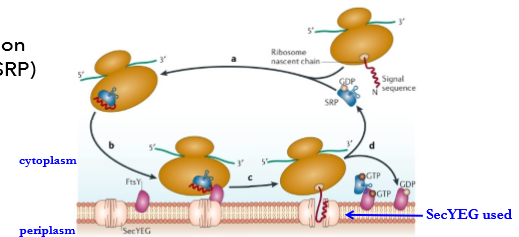
Sec vs SRP Pathways
Sec; post-translational translocation (protein is pre-made)
SRP; co-translational translocation (protein is synthesized during translocation). SRP proteins are more hydrophobic regions for membrane insertion, peptides not very stable in the cytoplasm, hence SRP system.
Both translocate unfolded proteins and share the SecYEG translocon
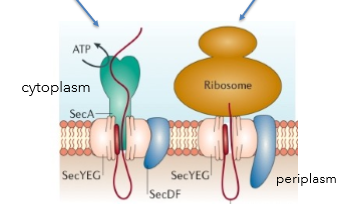
Tat System
A protein translocation system that transports fully folded proteins across the inner membrane of bacteria.
Terminal signal peptides on the proteins have a highly conserved Arginine-Arginine (RR) motif (twin arginine leader sequence/ the recognition motif)
Many proteins related to virulence are translocated via Tat System
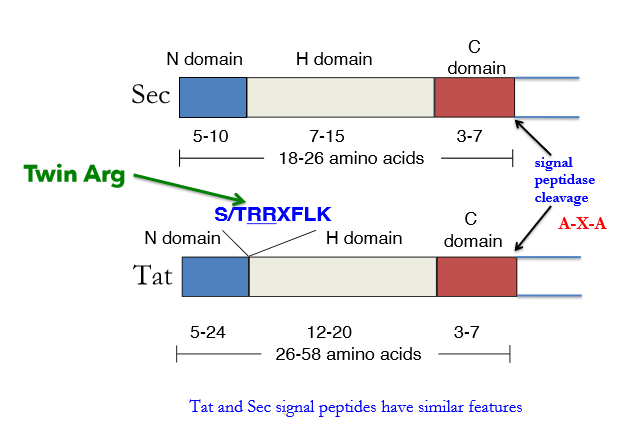
Tat Pathway
no protein substate; TatA and TatBC are separate
Twin Arg binds to and is recognized by by TatBC
Binding to TatBC triggers TatA polymerization, creating the protein translocating complex.
Protein is translocated, energy is from PMF
TatA and TatBC dissociate.
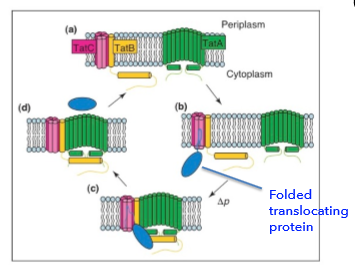
Secretion Systems (SS) in Gram - Bacteria
1-Stage Systems; Sec Independent, tunnels to secrete/inject proteins directly from cytoplasm to cell exterior or into host cell (Type I, III, IV, VI)
2-Stage Systems; Sec dependent, rely on Sec or Tat for protein translocation to periplasm (Type II, V, IX)
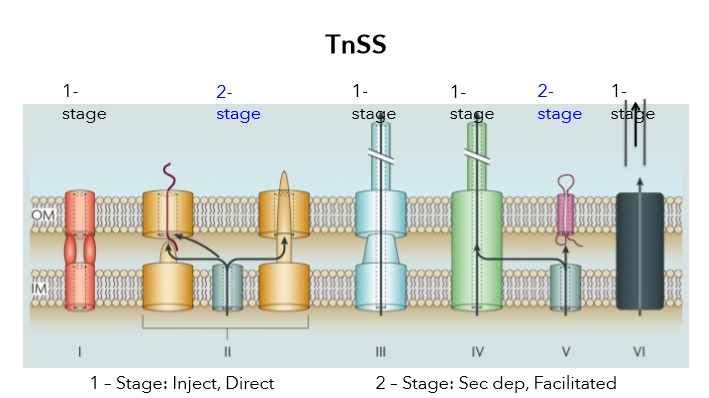
T2SS
2-stage
Sec/Tat dependent
Stage 1= transport protein by Sec/Tat to the periplasm
Stage 2 = transport protein across OM
Leader peptide is cleaved and protein is folded in the periplasm
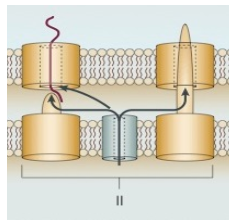
T5SS
2-stage
Sec dependant
Stage 1= transport protein by Sec to the periplasm
Stage 2 = transport protein across OM
2-partner System; 2 proteins secreted via Sec across IM/CM, TpsB(translocator), TpsA (effector)
Autotransporter; NaIP is a mutlidomain protein created as precursor protein across the IM via Sec, Traslocator domain inserts into OM and facilitates transport of passenger domain, excreated protein can remain ancoured to OM or be clevaed.
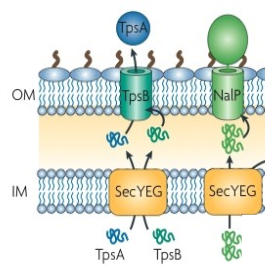
T1SS
1-stage
Sec independent
Simple channel of 3 proteins; 2 IM/CM proteins (ABC transporter involved in ATP hydrolysis and Membrane fusion protein MFP anchored to IM connect the OM protein) 1 OM protein (outer membrane pore)
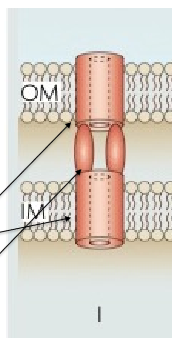
T3SS
1 stage
Sec independent
Nanosyringes produced by Gram - pathogens, Infection by injection, translocate proteins from the bacterial cytoplasm across 3 membranes to host cytosol. ATP dependent. Silimar to flagellar synthesis apparatus which is also made by T3SS.
3 Main Parts;
Basal Body; 2 IM/CM and 1 OM protein
Needle; long filamentous single protein forms a hollow channel for virulence factors to travel.
Needle tip and pore proteins; complex of protein that dock pore in host cell.
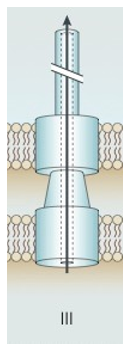
T4SS
1 stage
Sec independent
most common role: mediate conjugation, transfer of plasmid DNA, contributes to the spread of antibiotic resistance genes.
3 types:
Conjugation systems; translocate DNA to recipient cells through contact
DNA uptake or release from extracellular environment
Effector translocator systems, DNA or protein transferred as a virulence factor
*Nucleic acid transport is unique to Type IV system*
could be used for gene modification, such as GMO plants
